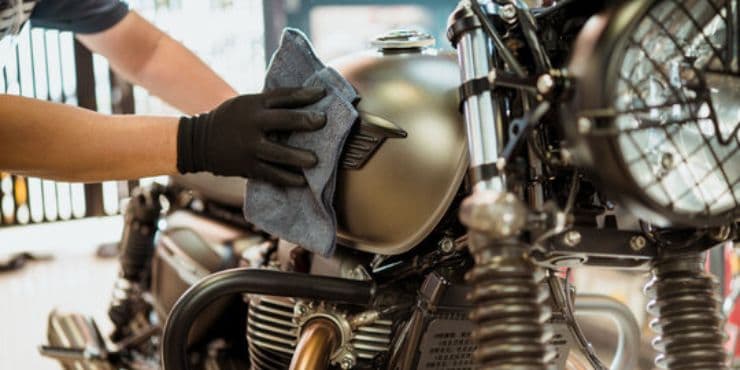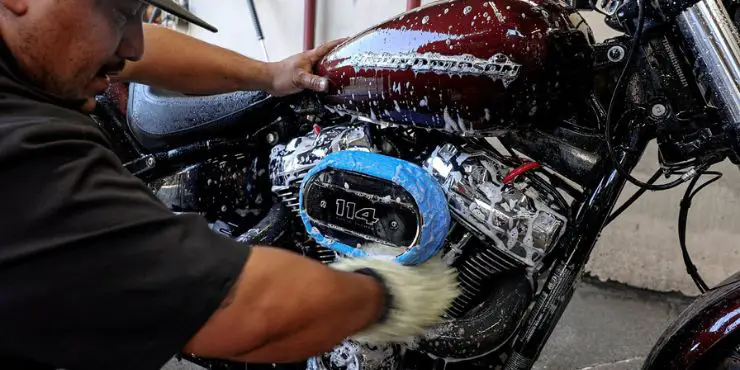Do you own a Harley-Davidson motorcycle and want to know how to wash it properly? If so, then you’re in the right place because you’ll get to know the thorough instructions here.
To wash a Harley, rinse the bike with low-pressure water to remove dirt, apply a motorcycle-safe cleaner, and use a soft sponge to clean the surfaces. Avoid high-pressure water near the electrical components and dry with a microfiber cloth.
In this guide, you’ll get to know all about washing a Harley-Davidson bike, cleaning products that you’ll need, how to wash a Harley, and more. Continue reading to get all the answers that you’re looking for.
Wash your Harley-Davidson motorcycle
If you ride a Harley-Davidson bike, then you’ll know how your bike feels and looks after a long day. Your windshield will be full of dust, dirt, and bugs. Meanwhile, debris can also be a huge annoyance to your daily ride. It’ll wreak havoc on your bike if you don’t wash your bike regularly. You’ve paid a lot of money for your Harley-Davidson bike, so you’ll need to ensure that it looks great day in and day out.
Knowing how to wash a motorcycle properly will save you a lot of money, time, and disappointment. Cleaning a bike doesn’t just remove corrosive substances from important parts and finishes, but it’ll also be an opportunity for you to look over your bike carefully. You can spot potential structural or connection issues that might not be evident from your daily perch in the saddle.
How to wash a Harley-Davidson motorcycle
Step 1: Gather up your cleaning supplies
The best way of washing your Harley-Davidson bike starts with ensuring that you have what is needed to get the job done. There are a few things as frustrating as clearing your schedule, positioning your bike, and realizing that you haven’t got the right supplies you need to get started. There are many motorcycle cleaners to choose from, so you won’t have to make do with any option. All that glitters isn’t always gold, and it means suds aren’t meant for cleaning bikes. From rinseless wash to detailing spray, when choosing products to clean your bike, ensure that they’re designed for the right purpose.
The less that you touch your bike while cleaning it, the better it’ll be. However, when you need to touch your bike, ensure that you’ve got the appropriate materials for the task.
Sponges
They’re great for removing stuck-on grime without causing any damage to the finish. However, make sure that they don’t pick up any pieces of dirt in the process, or they could scratch the paint.
Microfiber cloth
It is best for providing the finishing touches and final pass with detailing spray. A microfiber cloth will do a tremendous job of trapping leftover dust, lint, and more.
Brushes
Mainly designed for regions like spoked wheels that can handle elbow grease, but must be used in a limited capacity and only when other methods of dirt removal can’t do the job.
Chamois
It’s an ultra-absorbent leather cloth safe for all surfaces.
Cloth and flannels
These work amazingly for the initial drying pass post-wash.
Step 2: Get the working area in order
Once you’ve got everything you need to thoroughly wash your Harley-Davidson bike, you’ll want to ensure that both your bike and your work area are ready to go. Before you start, ensure that your bike is cooled down. Like a temperamental toddler, your bike has to be in the right mood for its bath. Pouring cold water on a hot engine can result in thermal shock. A quick shot of cold water essentially creates an unceremonious snapback, causing a lot of damage.
You should also look to avoid working in direct sunlight, which makes the soap dry faster. This will make it more difficult to do a decent job of cleaning your bike by increasing the probability of streaks and water spots.
Step 3: Plug the exhaust holes
While your bike is generally resilient when it comes to water, it certainly doesn’t hurt to plug your exhaust. You can even stuff a rag in the exhaust hole or cover it with a rubber glove to keep the water out. This step is most common with dirt bikes, but it should be something to consider for every bike. It’s essential for exhausts angled in a way that allows water to pool in them during the washing process.
Step 4: Give your Harley-Davidson bike a quick spritz
In simple terms, the less friction applied when cleaning your bike, the better it’ll be. The more you rub and scrub, the more likely you’ll be to have the sponge pick up small particles of dirt and grind them over delicate surfaces. To decrease the likelihood of this, you should spray down your bike with a combination of motorcycle cleaner and water before touching it with anything else. It’ll help loosen up the gunk and wash it away before finishing it off with elbow grease.
Now, you should apply a spray cleaner. Motorcycle spray cleaners will be applied to a dry bike before you rinse. They work to loosen up dried muck, bugs, and any other unsavory remnants of the road. After that, you should rinse the bike. Once you’ve let the motorcycle spray cleaner do its job, you should rinse it away with a standard-pressure hose. While rocking a power washer definitely sounds like a fun and efficient method to do this, you shouldn’t.
Step 5: Suds up your Harley-Davidson bike
After the initial pass with the hose, you should start to get to the meat of the process of cleaning your bike. This is the part bikers think of when thinking about motorcycle wash. As always, you should be careful when how much force you’re using. Here are a few other tips that will make your job easier.
- Start at the top of your bike and then work down
- Make sure that the solution you’re using is right for the surface that you’re using it on
- If the sponge picks up any dirt, grease, grime, etc. you should clean it thoroughly or swap it before you continue
- Change the wash bucket after a while as grit and grime do have a tendency to pool at the bottom
- Water and soap may spill on your motorcycle’s chain and brakes, but you shouldn’t scrub these areas as the coating is part of what makes them function properly
Step 6: Rinse your bike
This step needs to happen rather quickly after you lather up your ride. You shouldn’t let the soap solution dry on your bike, as it’ll cause swirls and streaks that are hard to remove. You shouldn’t be afraid to be thorough in this step. Furthermore, you should want to splash away any residue left, so get it from all angles.
Step 7: Dry your bike
Quickly after washing your bike, you need to dry your bike thoroughly. The water left in creases and crevices over time could end up causing corrosion. One of the best ways of doing this would be to use an air blower of some sort (snow/leaf blower, shop vac on reverse, or any other option). This will allow for a hands-off approach, which reduces swirls and saves you energy.

If you’re looking for a more tactical approach, you could always go for something like an S100 Drying Towel or natural chamois for gently wiping away excess water droplets. Many bikers will take their bike out for a ride as a way of finishing off the drying process. While it’s a much more fun way to get the job done, it’s essential to note that if your motorcycle has fairings, the air might be deflected away from certain areas, which stay wet. Moreover, you’ll have to be sure that you ride long enough for the engine to get hot enough to get the excess water to evaporate.
When you’re riding your Harley-Davidson bike for the first time post-wash, the brakes will likely perform slightly differently as they work off any excess water. It’ll be best to ride cautiously and work them out at low speed before you hit the streets at full force.
Step 8: Re-lube your motorcycle chain
In an ideal world, the exact parts of your motorcycle that you wanted to clean would get hit with the right amount of water and cleaning solution. However, as you may know, the world isn’t perfect all the time. By this point, you would have definitely splashed more than a little bit of soapy water or cleaning spray over lubed-up parts of your motorcycle. This will most notably be the case with the motorcycle chain. Your best bet would be to make sure that you have re-lubed before you log in any more miles.
Step 9: Wax your Harley-Davidson bike
By this point, your Harley-Davidson bike will be clean. You have likely taken the fight to the dirty opponent and come out victorious. However, diligence will be key, and with that comes the need for the defense of your bike. The process of polishing and waxing a motorcycle is basic.
Waxing your bike will make the most of your bike cleaning. A reliable product like S100 Carnauba Paste Wax will help seal in the glistening goodness of your paint while also protecting it from degradation handed down from the elements.
While wax will level out and protect any imperfections on surfaces, polishing will shave it down entirely. Ideally, you shouldn’t really be polishing, as it could cut away layers of your clear coat on each pass.
Conclusion
Thanks for reading. Hopefully, now you know a lot more about washing a Harley-Davidson bike, cleaning products that you’ll need, how to wash a Harley, and more. Washing a Harley-Davidson involves gathering the cleaning supplies, getting the working area in order, plugging the exhaust holes, giving your Harley-Davidson bike a quick spritz, rinsing your bike, and drying your bike. Knowing how to wash a Harley will help you save time and money and prevent any long-term damage to your bike. Not just that, washing and cleaning your bike will help you notice any structural or connection issues.

